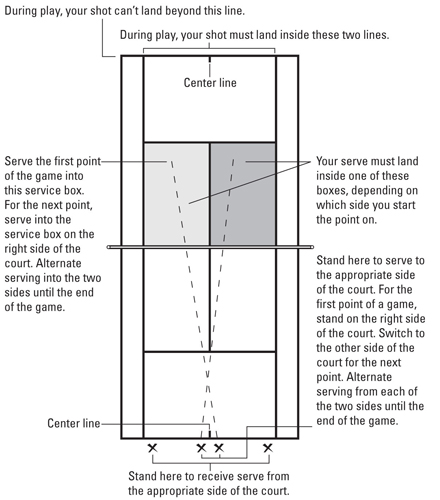>
Explaining the Singles Tennis Court
A familiarity with the singles tennis court is a must-have for every tennis player. Even if you specialize in doubles, you need to know where the service boxes and the baselines are. The following image shows the tennis court and where to stand when serving and receiving serve.

>
>
>
How to Play a Tiebreaker in Tennis
When tennis players win six games each, they generally play a tiebreaker to decide the winner of the set. (Tennis rules governing tiebreakers differ for team tennis and for the Wimbledon Championship and may differ for local tournaments as well.) If you're playing a tiebreaker, follow these steps:
The player due to serve the 13th game serves the first point into her opponent's deuce court.
After the first serve, the serve goes over to the other player, who then serves the next two points, serving first into the ad court and then into the deuce court.
After the third point, the players alternate, serving two points each — always beginning on the ad court.
After the first six points are played, no matter what the score is, the players change ends (and continue to do so after every other six-point span) until one player wins at least seven points with a margin of two points.
The player who serves the last game of the set before the tiebreaker serves the first game of the new set following the tiebreaker.
>
>
>
Essential Tennis Terms to Know
Tennis, like any sport, has its own lingo, and tennis uses perhaps the most well-known sports term — love, which means zero. The following list offers definitions of basic tennis terms:
| ace: A serve that the returner doesn't even touch with her racquet. An ace wins the point immediately for the server. | lob: A shot that you hit with any stroke high and deep into your opponent's court. You typically use a lob to get the ball past an opponent when she stands at the net. |
| backhand: The side of your body that you usually don't do business on. For example, if you're right-handed, your backhand side is the left side of your body. | netpost: The two very hard metal posts that hold up the net. (You'll find out exactly how hard they are if you ever run into one.) If your shot hits one of the netposts during play and bounces in your opponent's court, the shot is good. |
| baseline: The line, parallel to the net, which defines the outer-most edge of the court. | overhead: A shot you hit over your head during play, either on the fly, or after the ball bounces. The overhead is also known as a smash. |
| center line: The line in the direct center of the baseline. You must stand to either side of the baseline when you serve. | passing shot: A forehand or backhand you hit past an opponent when she stands at the net. |
| drop shot: A very soft shot hit just barely over the net. You hit drop shots to get your opponent up to the net. | seed: A player's rank in a tournament. |
| foot fault: You commit a foot fault when your foot (or any other part of your body, for that matter) touches the baseline or center line during your serve. You automatically lose the service attempt when you foot fault. | serve: A stroke, made from over your head, which you use to start each point. |
| forehand: The side of your body that you perform most tasks on. For example, if you're right-handed, the right side of your body is your forehand side. | sideline: The lines on the court, perpendicular to the net, which define the widest margins of the court. |
| Grand Slam: Winning the U.S. Open, Australian Open, French Open, and Wimbledon all in one year. | spin: Hitting the ball in such a way that when it bounces, it does some funny things that your opponent doesn't expect. |
| grip: The way you hold your racquet. You can choose from three standard grips in tennis: the eastern, continental, and western grips. | volley: A shot that you hit before the ball bounces, usually at the net. |
| groundstrokes: Your basic forehand and backhand strokes. |
>
>
dummies
Source:http://www.dummies.com/how-to/content/tennis-for-dummies-cheat-sheet.html
No comments:
Post a Comment